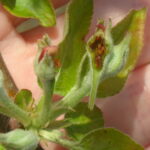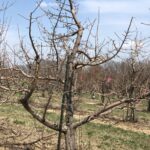Freeze:
There really isn’t much that can be added to the wonderful and unfortunately timely article about Frost. Critical Temperatures and Frost Protection by Rob Crassweller at https://extension.psu.edu/frost-critical-temperatures-and-frost-protection
With a frost to freeze expected to cover most of the state on April 21 and 22, there will certainly be crop damage and loss (Fig. 1). The extent of the damage we can expect will be highly variable. Our mild winter, followed by an early and mild spring, has resulted in many trees at Meigs (and throughout the state) having buds that are at different stages of development, from silver tip to bloom, all on the same tree (Fig. 2). That may be a silver lining in what is shaping up to be another tough year.
Some of this is due to weather, and some of this variation is genetic. Even with some cultivars more prone to this type of erratic growth than others you can still find adjacent trees of the same scion and rootstock showing marked differences. As a result, the buds on these trees are not equally susceptible to damage. How much damage that does occur will depend upon cultivar (some are more sensitive to freeze than others, like Delicious) and will depend upon the health of each tree (even though they are clones). In the case of individual trees, healthy and vigorous trees will weather these insults better than trees that are already struggling.
- Figure 1. Freeze damage to apple blossom buds. Photo by Janna Beckerman.
- Figure 2. In 2021, the mild winter and cool spring resulted in asynchronous phenology of many apple trees at Meigs. This image was taken 4/6/2021. Note the variation from silver to tight cluster.
Apples and Pears:
Despite the loss of fruit crops, disease management, particularly for fire blight, is of the utmost importance right now. Improper management of trees from this point on can profoundly affect future harvests. Freeze injury, much like hail injury, results in damage to young and succulent shoots and leaves, providing a means for the fire blight bacterium to cause shoot blight. Running both Cougar Blight and MaryBlite right now shows zero risk of infection, as temperatures remain below 60 degrees F. However, temperatures in the 70s will return by the weekend.
For those trying to preserve their crop (or who haven’t given up just yet), streptomycin will provide protection against fire blight. If the crop is lost (full bloom, temperatures below 28 degrees F even for a few hours), a low rate of copper (0.2 -0.6 lb of metallic copper/acre depending on tree row volume) can be used to minimize the risk of fire blight. Keep in mind that copper can cause injury on some varieties, and application should occur after the temperatures are above 50 degrees F to prevent phytotoxicity. Suggested coppers include Cuprofix, Kocide, or C-O-C-S. Turner Sutton, at North Carolina State University reports using the 0.2 and 0.4 lb rates on Golden Delicious during the summer without any problem. If you think you might have a crop on a copper sensitive variety, use streptomycin if you are concerned about possible injury and may still have a small amount of fruit to harvest.
According to the prevailing wisdom, dead flowers that don’t fall off are not good hosts for the fire blight bacterium. Many of our apple varieties at Meigs seem to be asynchronous with their bloom time this year and any of these slow to flower side blossoms or “rat tail” blooms that are still alive can become infected. Continue monitoring until bloom is over, and apply streptomycin as needed, not to exceed four applications per season.
If your orchard has a history of fire blight, or to just manage the vigorous growth due to last year’s crop loss, I would strongly encourage you to consider applying Apogee (Prohexadione-Ca). Apogee is a growth regulator that does not directly kill the fire blight bacterium, but reduces shoot growth, thereby increasing plant resistance by reducing host vigor. Apogee suppresses apple shoot growth when applied near petal fall as a single spray, or as several applications over time. Apple response to Apogee depends upon the cultivar, timing, rate of application, crop load, and even geographical location. Regardless of this variability, Apogee remains the best management tool available for controlling the shoot blight phase of fire blight that growers may be faced with after a freeze, particularly after the vigor that may result after crop loss.
Despite the potential, or real loss of crop, it is imperative to maintain a least a minimum spray program to protect future harvests. Failure to do so will result in defoliated trees that fail to produce next year, or may not survive the next winter. Normally, the greatest risk of scab would be right now, from pink to bloom. However, nothing is normal about this year. For these reasons, I am recommending:
- EDBC fungicide (3 lb/acre) program through bloom. Alternate with copper or sulfur from second cover on to remain under label limits. Remember to stay within the 21.0 lb/acre/season limit for your EBDCs. I like the EBDCs as they also protect against bitter rot, black rot and white rot. Use this schedule if cedar-apple rust is a particular problem.
- Alternatively, Captan can be used earlier in the season for better scab control instead of the EBDCs, but provides no control of rust or powdery mildew.
- NOTE: Do not use Captan 50 Wettable Powder in combination with or closely following or in alternation with wettable sulfur products, or oil. Sulfur sensitive varieties of apples such as Red Delicious, Staymen, and Baldwin, can suffer severe injury and defoliation. Captan 50 WP has a 64 lb limit per acre per year.
One other option that can be used is copper (0.2 – 0.6 lb metallic copper per acre based on tree row volume) + sulfur (6-30 lb/acre depending on brand/formulation) every 10-14 days between now until the first week in June, depending upon weather conditions. Suggested sulfur formulations include Thiolux, Microthiol Disperss, or Microfine Wettable sulfur. This spray program protects against scab and mildew, and slightly against rust. Remember, copper can russet fruit, and should not be used if you want to use your crop for anything except cider. Do not use sulfur if temperatures are going to exceed 90 degrees F, or drying conditions are extremely poor. Do not use sulfur or copper within two weeks of an oil application. Neither of these programs is going to provide complete scab control but should reduce leaf infections. Organic trials in both Michigan and North Carolina regularly apply 6 lbs of sulfur per treatment without any reported phytotoxicity due to temperature.
If powdery mildew is particularly bad, you may wish to consider applying a FRAC 3 like Rally or Procure, or a FRAC 11 like Flint or Sovran prior to second cover to knock down powdery mildew and reduce the likelihood of it overwintering in bud tissue, particularly are on higher value cultivars (like Honeycrisp, Jonagold, etc). Reducing inoculum levels to maintain plant health while reducing overwintering inoculum is important for long-term plant health, and to reduce inoculum buildup which contributes to fungicide resistance.

Figure 3. Fire blight still caused infection of freeze-killed blossoms in highly susceptible varieties like Gala and Fuji, or in quince, as seen here. Photo by Janna Beckerman.
Managing Diseases on Stone Fruits:
Late spring freezes and severe winter cold regularly causes stone fruit crop losses to approach 100%. With this level of irregular cropping, disease management must focus on protecting foliage to ensure a good potential crop for next year, while reducing over wintering spore loads. Copper is fairly phytotoxic to peaches and should be avoided. Bravo is another low(er) cost alternative if disease pressure become high, but fruit is absent.
- Captan at the 1.3 lb/ 100 gallon rate should sufficiently control brown rot twig blight, scab on peaches and cherry leaf spot.
- If the season is excessively wet, higher rates of captan may be required.
- Captan will not control powdery mildew.
- Wettable sulfur at the 6 lb per 100 gallon rate is probably the least expensive material you can use and provides excellent control of powdery mildew of all stone fruit
- Wettable sulfur should aid in controlling brown rot twig blight, and peach scab.
- Flame Out (Oxytetracycline) or Mycoshield should be used to control bacterial spot on peaches, particularly if the weather is wet in late June and July.
For more information, see: BP-179 Disease Management for Fruit Trees After Crop Loss at
https://www.extension.purdue.edu/extmedia/BP/BP-179-W.pdf

